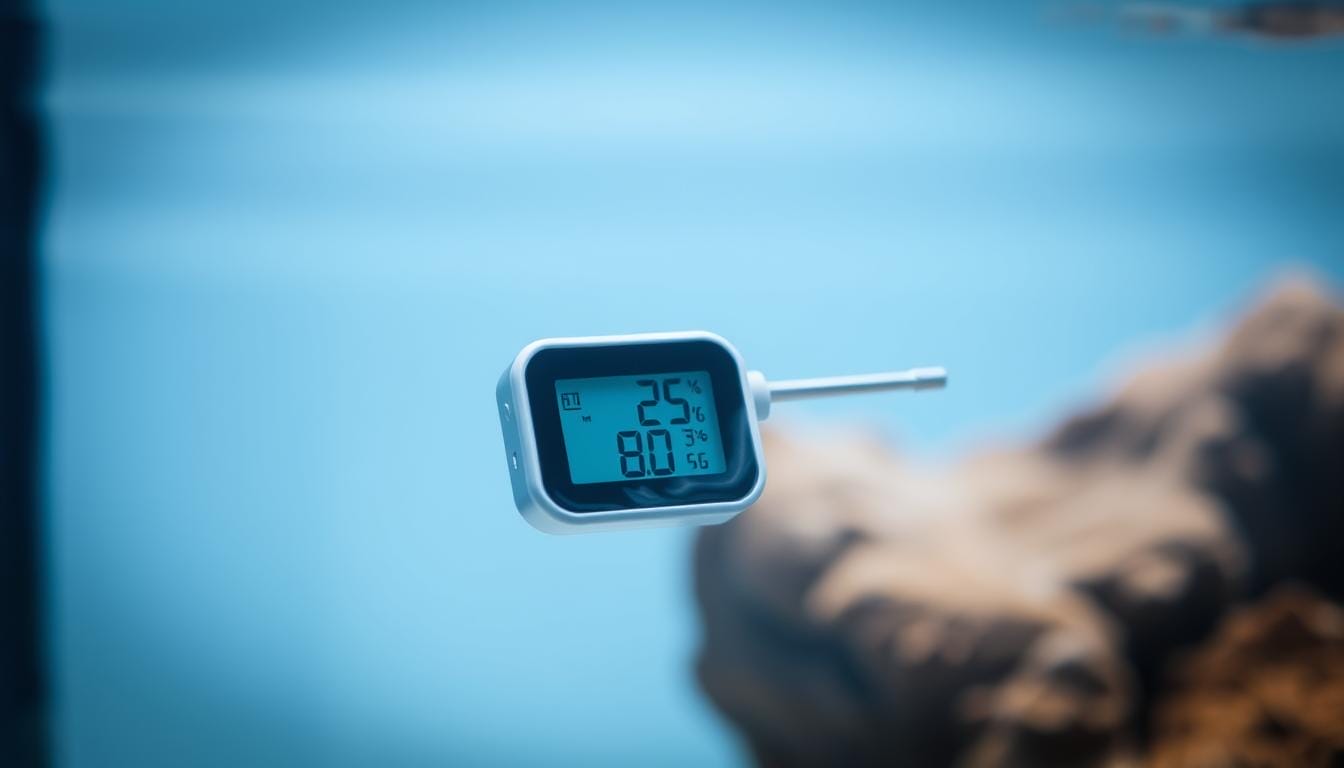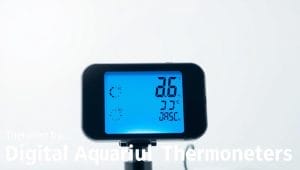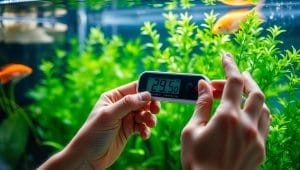
Best Aquarium Thermometers for Your Tank’s Health

Did you know a 2°F temperature swing can trigger stress responses in tropical fish? Your underwater ecosystem relies on precise conditions to flourish, much like a carefully tuned orchestra. Without consistent monitoring, invisible changes could quietly threaten the vibrant life you’ve worked hard to nurture.
Imagine your finned friends swimming in water that mimics their natural habitat perfectly. That’s where reliable tools come into play. They act as your eyes beneath the surface, alerting you to shifts before they become emergencies. Whether you’re raising delicate shrimp or hardy goldfish, stability isn’t optional—it’s essential.
This guide cuts through the confusion of choosing monitoring devices. You’ll discover how modern solutions blend accuracy with ease of use, giving you peace of mind. We’ll explore why some methods outperform others and how to spot red flags in your tank’s environment.
By understanding the relationship between temperature control and aquatic health, you’ll prevent common pitfalls. From unexpected algae growth to sudden equipment malfunctions, proper oversight keeps your ecosystem thriving. Let’s find the perfect match for your setup together.
Featured Aquarium Thermometers to Enhance Your Tank
What if your tank’s temperature could be monitored as effortlessly as checking the time? Modern solutions like liquid crystal devices simplify this critical task while delivering reliable results. Let’s explore options that blend practicality with precision.
Liquid Crystal Thermometers: Accuracy and Versatility
The FB0238 model stands out for its user-friendly design and consistent performance. At $7.35, this product uses color-changing crystals to show real-time readings between 65-85°F. Its ±1°F accuracy helps you spot subtle changes before they affect sensitive species.
Placement matters more than you might think. Stick it below the waterline on the front glass, opposite your heater, for the truest reflection of your tank’s conditions. The adhesive backing allows hassle-free adjustments—perfect when rearranging decorations or upgrading equipment.
Why These Tools Matter for Healthy Water
Stable temperatures prevent stress-related illnesses in fish and support beneficial bacteria colonies. Imagine catching a heater malfunction instantly because your device shows a sudden drop. That’s the peace of mind these tools provide.
Beginners love how these thermometers install in seconds without tools. Veterans appreciate being able to move them as tanks evolve. Either way, you’re investing in a clearer understanding of your underwater world’s delicate balance.
Digital Aquarium Thermometers: Features and Top Picks
Picture this: a quick glance at your tank reveals exact water conditions without squinting at tiny markings. That’s the convenience modern digital tools bring to your aquatic care routine. Let’s explore models that combine smart technology with budget-friendly choices.

Spotlight on American Marine and Coralife Options
The American Marine Calibration Thermometer (RAM21070) shines for precision-focused keepers. At $19.59, it’s ideal for breeding tanks or delicate species needing ±0.5°F accuracy. Pair it with the Coralife Digital model (RES00232) at $9.89 for reliable daily checks—both blend affordability with performance.
Comparing Product Prices and Shipping Details
Options range from MarineAndReef.com’s $0.99 stick-on item to Lifegard’s $51.95 multi-function unit. Need LED clarity? The $30.88 RRL31438 model delivers crisp readings day or night. Smart shoppers save with free shipping on orders over $49—smaller purchases ship for just $5.99.
Modern Digital Displays and Calibration Benefits
No more guessing games. Bright screens show exact numbers instantly, like Lifegard’s hygrometer combo tracking humidity too. High-end picks offer recalibration features, ensuring years of trustworthy data. Choose what fits your needs: basic monitoring or advanced ecosystem management.
Every product here solves different challenges. Whether you prioritize price, precision, or extra features, there’s a match waiting to simplify your maintenance routine.
How to Select the Right Aquarium Thermometer for Your Needs
Choosing the perfect tool starts with knowing your tank’s unique story. Every setup has different demands—whether you’re managing a compact 10-gallon space or a sprawling reef environment. Let’s break down what truly matters when picking your monitoring partner.

Key Factors: Placement, Price, and Product Type
Start by mapping your tank’s layout. Devices near filters or heaters might show skewed readings. Stick-on models work well for glass tanks, while digital probes excel in acrylic setups where adhesives fail.
Your budget plays a role too. A $5 strip could suffice for basic checks, but precision digital units justify their higher price for sensitive species. Remember—the most expensive item isn’t always the best fit for your routine.
Tips for Ensuring Accurate Temperature Monitoring
Test multiple zones daily. Surface water often runs warmer than lower levels. Place your thermometer mid-tank, away from equipment, to capture true conditions your fish experience.
Calibrate digital models monthly against a trusted reference. For analog types, clean the display regularly to maintain visibility. Pair your chosen device with alerts or logs if you travel frequently—consistency keeps ecosystems thriving.
Reflecting on Aquarium Thermometers and Your Tank’s Future
Your tank’s vitality begins with a simple choice today. Selecting the right product creates ripple effects—healthier fish, balanced ecosystems, and fewer emergency fixes. Remember, price tags don’t always reflect true value. A budget-friendly strip might serve you better than premium gadgets if it matches your routine.
Stay connected with suppliers through email updates for maintenance alerts and new releases. These messages often include seasonal care tips or exclusive deals, helping you adapt as your setup evolves. The skills you’ve gained extend beyond temperature checks—they’ll guide equipment upgrades and species introductions.
Share discoveries with local hobbyist groups or email forums. Every success story strengthens our community’s knowledge base. Your journey doesn’t end here—it’s a launching pad for deeper aquatic exploration. What wonders will your carefully nurtured environment reveal next?
FAQ
Why is monitoring water temperature so important for my tank?
Stable temperatures keep aquatic life healthy and reduce stress. Even small fluctuations can weaken fish immunity or disrupt biological filtration. Reliable monitoring helps prevent costly equipment failures too.
How do digital options compare to traditional stick-on models?
Digital devices like the American Marine Pinpoint offer precise readings (±0.1°F) and alerts for sudden changes. Stick-ons work for basic checks but lack advanced features like calibration or memory functions.
Where’s the best spot to place my thermometer?
Install it away from heaters, filters, or direct sunlight. For glass tanks, position the sensor mid-depth on the shaded side. Hang-on-back styles like Coralife Digital work well for consistent flow areas.
Are premium brands worth the higher price?
Brands like Fluval or Hikari invest in durable materials and accuracy testing. While budget-friendly options exist, investing in a trusted product often means fewer replacements and better long-term performance.
How often should I calibrate my device?
Check calibration every 3–6 months using a glass mercury thermometer as a reference. Digital models with self-calibration (e.g., BRS Titanium) simplify maintenance and reduce errors over time.
Can I trust free shipping offers for delicate items?
Reputable sellers like Chewy or Marine Depot use protective packaging. Always verify return policies in case of damage. Look for insulated shipping during extreme weather.
What’s the safest way to monitor temperatures long-term?
Combine a digital display with a backup stick-on strip. Set alerts on apps like Seneye for remote monitoring. Regularly compare readings to catch sensor drift early.
How do I future-proof my setup for different species?
Choose adjustable models with wide ranges (59–104°F). Brands like Inkbird offer dual probes for multi-tank setups. Prioritize devices compatible with heaters or chillers for automated control.





